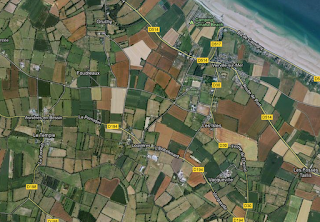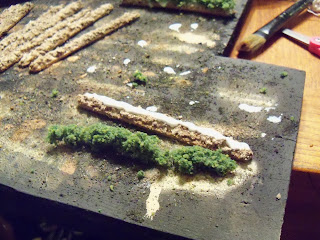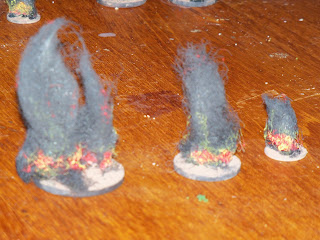I wouldn't say I'm cheap. Well, my wife would. So would my kids. And my parents. And pretty much anyone who knows me. So when I decided to game the Normandy Campaign of 1944, I was a little anxious about filling the table with bocage terrain. All those hedges, done in resin, would be incredibly expensive. Besides, I wasn't thrilled with the look of the commercial models available. I had been to Normandy in 2004, and I wanted a combined earthen embankment with bushy foliage atop it. And I wanted lots of 'em, so that my table would look a little like the image below, taken from Google Maps of the land just inland from Omaha (where my Grandfather landed on June 7th. He was in the 29th but his regiment, the 175th, avoided the 'Saving Private Ryan' landing by being the divisional reserve).
My mission, to make lots and lots of hedgerow markers. They had to be cheap, they had to be quick, and they had to look good. I assembled the following materials:
*Popsicle sticks (thank you dollar store!)
*White glue (again, a dollar store special)
*Small pebbles (is use commercial talus, a $3 bag I bought years ago. I used maybe a tenth of it in this project)
*Sand.(I took a jar from the playground where my kids play)
*Craft paints ($2 a tube. You need some to represent earth, and some white to lighten it for drybrush highlights)
*JTT Coarse Foliage-Fiber Clusters (Light Green). (At $5 a pack, this was the expensive part of my project. A pack is good for about 40 4" hedgerow sections)
I did my hedgerows in batches of 16-18. First, I laid down a thick coat of white glue on each popsicle stick.
Then, I packed as much talus onto each stick and allowed it to dry overnight. My goal was to add some shape and height to the embankment, which I would not get if I simply used sand alone. I suppose this process could be repeated for an even steeper embankment, but for me it was not worth the time.
The next day, I covered the talus with a watered down white glue (1 part water to 1 part glue). Then, I liberally spread sand atop the glue. This takes some of the rough edges off the talus, making the embankments look more like earth than rock formations. Then I allowed them to dry overnight.
Apply a coat of spray primer. I use black. I suppose I could have saved time by using a brown color similar to the earth tones I normally use for dirt. No biggie, though. When that was dry, I applied brown craft paint liberally on each popsicle stick. Craft paint is not as pigmented as my model paints, so a few coats were needed. Craft paint is cheap, though, and these are simple to paint, so it went fast anyway. When I was happy with the result, I applied a lighter shade with a drybrush to bring out details and textures in the embankment. You can see the different drybrushing makes in the stick in the foreground below.
One last step: apply a generous line of undiluted white glue atop the painted embankment. Pull out a foliage clump and roll it into a 4" long snake. When it is the right length, press it firmly into the strip of glue.
The finished product. It stands about 1.5-2.0 centimeters high, more than enough for 10mm or 15mm troops to seek shelter behind.
And here is my latest batch laid out on my dining room table. Three more batches, and I should have enough for a real boage rumble. Cost per 4" section works out to under $.20. And while they took three days to make (owing to the time each layer of glue or paint took to dry), actual worktime was under two hours for 18 sections of hedgerow.
At the same time, I also bade some quick and easy artillery blast markers. All it took was some steel wool (#oo grade), some epoxy cement, sand spray primer, a few pennies, and some paints.
First, I tore clumps of steel wool about 3" high and used the epoxy to glue them to the pennies. I sprinkled some sand around the edges of the base, to create more textured earth when I painted them up. I teased the steel wool out into slightly irregular shapes so it looked like a rising smoke cloud.
Back spray primer creates the distinct impression of a smoke cloud. I left several markers unfinished at this stage to use as smoke markers on my battlefield. For artillery blasts, I saturated the steel wool close to the base, first with red, then with yellow paint. Then, I lightly brushed the outer fibers with yellow, red and white. Paint and highlight the bases an earthen color and...voila! Blast markers for mere pennies!



















